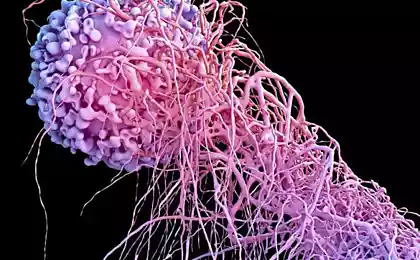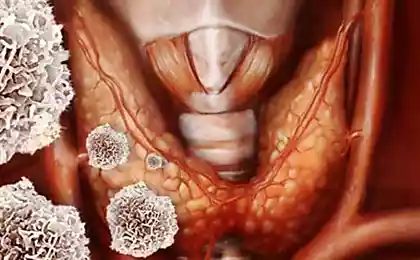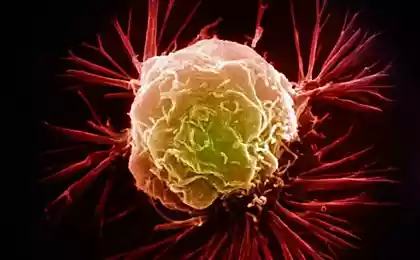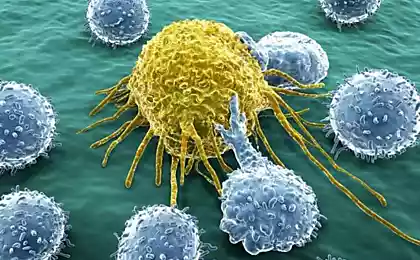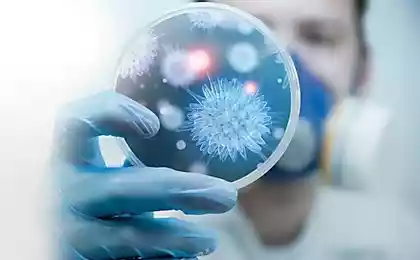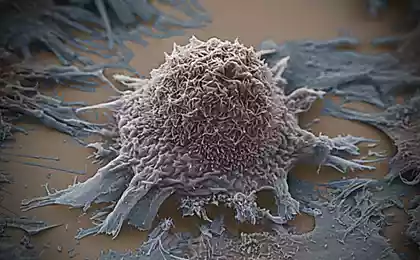669
Cancer has always been with us: the progression of the disease throughout the history of mankind
One study was devoted to the study of the incidence of cancer in prehistoric times and its implications for us today. In the article special attention is paid to the evidence that the remains of primitive people were found traces of cancer. Yes, cancer has always been with us, but the question is whether the incidence constant throughout the history of mankind or he was sharply accelerated with the advent of modern diets, lifestyles and the release of industrial toxins into the environment. It may seem that the answer is obvious, but it is not a fact – at least for some scientists.
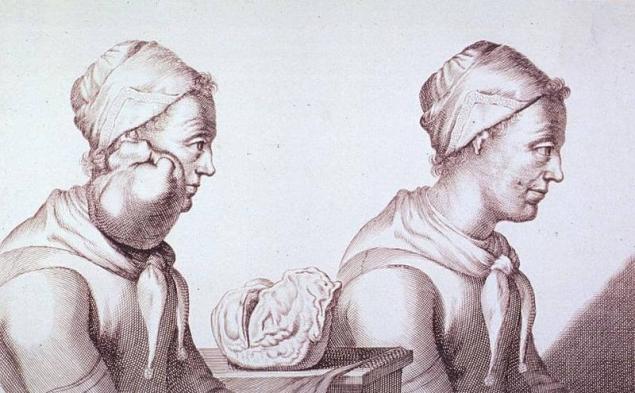
image wikipedia.org
Cancer has always been with us
The reason for this article was found during excavations of the Scythian burial mound of the remains of the men and women who died approximately 2700 years ago. According to scientists, almost every bone in a man's body was infected with cancer, making this find the oldest of all known cases of detection of metastasis of prostate cancer. Scientists say that the bones present a specific pattern of scars that is identical to the path of migration of cancer cells from the prostate gland. The decisive argument, however, is the fact that the proteins extracted from the bone tested positive for the marker prostate-specific antigen – an indicator of prostate cancer.
And although the researchers once again confirmed that cancer accompanies man from the beginning of its existence, discovered the remains have not given anything that could shed light on the more important question: does increased cancer rates throughout human history? Different diet, lifestyle and exposure to toxic environment increases our chances of getting cancer? Or do the statistics remain the same?
The incidence of cancer among ancient people is difficult to calculate
The biggest problem that scientists in search of an answer to this question is that simply not all the remains can be explored, to make an accurate conclusion. In the history of archaeology was able to identify presumably more than 200 cases of cancer in prehistoric times.
But what does it mean really?
According to reports, there are approximately 100,000 ancient remains, and many of them involve only the skull. For a long time archaeologists only collected skulls, no other bones. And even so, very few of the skeletons, whole or at least their components, have been studied using modern methods. But it gets even harder when you consider that:
1) Unless the tumor goes to the bone, it will not manifest itself. If the primitive woman was bleeding from colorectal cancer, it remains after decomposition of soft tissue I know this is not possible;
2) again, if the cancer reaches the bone, it can cause their destruction and, consequently, they simply disappear, leaving no trace;
3) Another problem is that cancer is usually associated with aging. The older you get, the greater the likelihood of developing cancer. But in primitive times, people often died when hunting mammoth in thirty years than from disease at eighty. The Picts and the Celts, though they lived much later, also usually had no chance for the manifestation of such diseases as cancer, because they died from other causes much earlier.
So all the evidence look, at least, doubtful.
To sum up a little:
1) a New disease: signs of a cancer rarely found in ancient remains, therefore, cancer was a rarity among the people of those times. Thus, cancer is modern disease associated with diet, lifestyle (e.g., Smoking) and exposure to environmental toxins;
2) Old disease: nothing really modern in the incidence of cancer there. The disease was less common among ancient peoples because:
— they died before they could get cancer;
— currently in most cases no evidence of the disease in ancient man's remains cannot be found;
3) the Inevitable disease: some scientists argue that cancer is inevitable, coming at a time when individual cells are "licensed" to reproduce. "If we lived long enough, sooner or later, everything would have earned himself cancer".
So the increased incidence of cancer or not?
If ancient remains are too few and they are in the wrong to research the condition, and people were dying too early to be able to obtain the necessary data, it may be a different source of evidence? And the answer is obvious: Yes, this is the beginning of the 20th century. In this period of time the medical community was quite aware of cancer and is much better able to recognize tumors and diagnosing cancer than doctors of previous eras. In addition, people born in the early 20th century, lived longer than their prehistoric ancestors (in fact, their life expectancy was almost the same as modern humans, if successfully overcome the disease in childhood). In the 20th century was marked with many of the problems associated with cancer occurrence, including:
1) a Sharp increase in meat consumption;
2) transition to a high consumption of processed foods and fast food as the main part of the diet;
3) the Transition to diets high in omega-6;
4) the Emergence of more than 100 000 industrial toxins that had never been seen in history before, and release them into the environment by hundreds of thousands of tons;
5) Mass use of known carcinogens such as chlorine and fluoride in the municipal water supply;
6) Leap of Smoking in society after the Second world war.
The point is, if we assume that cancer has always accompanied mankind, and you want to know whether the increased incidence in recent years, does it make sense to turn to the ancient remains when, many factors can be tracked according to the 20th century, when radical changes occurred?
Cancer in the 20th century
Forget about the bones. Forget about the missing soft tissue. Forget about early death and not diagnosed. All this has very little impact on our ability to determine the actual incidence of cancer in the 20th century. And yet at this time the most potentially hazardous elements mentioned above, have become part of our lives. If the cancer has deteriorated markedly in the 20th century, then the evidence is pretty clear evidence of the influence of these factors. If the situation has not changed or improved, then you can say about another conspiracy theory.
It is not surprising that there are two points of view when talking about the statistics of incidence of cancer over the past 100 years.
One report says that:
"In recent decades, according to many, cancer is gaining momentum due to increased usage of chemicals. But if chemicals were a source of health problems, one would expect adverse effects on life expectancy, the incidence of cancer or other diseases around the world. However, in developed countries where chemical use has greatly increased, people began to live longer and live a healthier life."
For clarity, we refer to the schedule
The caption of the image: the death rate from cancer per 100 thousand people in the USA
Yeah, that looks pretty convincing! Cancer mortality is clearly not increased in recent years; figures have gone down. Here is the theory that cancer is a "modern" disease. Except for one tiny problem: the graph starts in 1975. Why not earlier, after all those years, too, there is evidence?
You need to go on the schedule published in a research article. See for yourself how rates of cancer have changed in Sweden during the 20th century, and what is happening on each chart in the mid 70's, from which the first chart is only the beginning.
The caption of the image: the female mortality from breast cancer
The caption of the image: the death rate from colon cancer in Sweden
You can see that the level of all types of cancer after several years of explosive growth peaked in the mid-seventies. As the saying goes, there are three kinds of lies in the world: lies, damned lies, and statistics. Selective use of data on the incidence of cancer in the mid 70-ies combines all three kinds of lies immediately. It is obvious that although cancer is an ancient disease, mortality from this disease has increased dramatically in the 20th century.
And the truth is, not all cancers peaked in the mid 70-ies – it is impossible to trace in a General graph.
For example:
The caption of the image: lung cancer mortality (Sweden)
The caption of the image: the death rate from melanoma since 1912 (Sweden)
The caption of the image: the mortality rate from prostate cancer since 1951. After a short recovery in the mid-70's, the figures started to grow again.
At the time, premarin was the most prescribed medication in the world. Now that numerous studies have shown that it can cause anything from cancer to a heart attack, assign it according to the recipe halved. Thus, some stabilization of mortality from breast cancer (and ovarian) over the past few years has provided the prescription of new drugs.
A breakthrough in reducing mortality rates from colorectal cancer largely depends on the new world epidemic – fibers. At the time, contained in our diet in abundance, fiber has virtually disappeared with the proliferation of fast food and processed foods. But thanks to the active promotion of a diet high in fiber (which the medical community has approved not at once), the incidence of colon cancer has finally begun to level off. And Yes, early detection and improved surgical techniques have also improved performance.
Morbidity and mortality from lung cancer directly related to Smoking cigarettes. In countries that significantly reduced their use (e.g., USA), mortality rates from this cancer have begun to change dramatically. In Asian countries (such as China) where for the last decade surely caught Smoking, mortality rates go up. By the way, cigarettes contribute to the emergence of many types of cancer besides lung cancer, including: cancer of the lips, jaw and throat, and cancer of the bladder and pancreas.
The sun and tanning beds contribute to the incidence of skin cancer.
Conclusion
So what do we really know about cancer?
First, we know that he was always with us from the earliest days of human existence (whenever it was). Most of the animals sick with cancer. Even some plants cancer manifests itself in the form of growths. And why not? In fact, cancer is simply a MIS-programmed cells, which begin to run amok. Every day your body produces from several hundred to tens of thousands of such cells during normal metabolic processes. The trick is that if your immune system is healthy and not overloaded with too many cells rogue, she gets rid of each of them. What we call cancer occurs when the immune system no longer can do its job and allows some of these cells to survive long enough for it to start replicating and "to equip a foothold" in the body. Once the diseased cells will provide yourself with a support system that will allow them to feed themselves, you will be able to start the production of bio-chemicals that promote their own existence at the expense of healthy cells. This is cancer.
Thus, the potential for cancer is in every living being.
We also know about all nonsensical prehistoric arguments in favor of the fact that the incidence of cancer has increased dramatically over the last century. The number is. The information is also. Of course, now doctors can diagnose tumors much better than 50 or 100 years ago, but this is a lifetime diagnosis. After death, when dissected, any pathologist of the last century would recognize a large foreign body in the colon cancer. It is recorded of death from cancer. But is this always the correct diagnosis? No. Of course, we can assume that in the 1940's and 50-ies of the doctors were completely incompetent and did not notice the tumor when he performed the autopsy or treated injured when the inside of the soldier was right in front of them. It's also possible that the extra 3-7 years that people live now, 100 years later, influenced by. And Yes, life expectancy has really increased over the last hundred years – taking into account the reduction of infant mortality, which greatly distorts the figures. Yes, all this is possible... but not very likely. All this can only to argue, because to prove it as to disprove it is impossible.
And finally, we absolutely know that choose a diet and way of life and exposed to toxins that affect our chances of getting cancer. Again, try to prove the opposite. Take, for example, cigarettes. We know that in any group of the population among smokers are far more common, and various types of cancer, unlike non-smokers. Is it possible with absolute precision to prove the connection between cigarettes and cancer? No. You can always find someone who smoked two packs a day for 50 years, but never got cancer. But any sane person knows that if you smoke a lot, your "chances" of getting cancer is much higher.
Similarly, we know that certain dietary choices, chlorinated water, radon gas in our homes and exposure to numerous toxins significantly increase the risk of developing cancer. It is a struggle for the probability, and we want the odds were in our favor.
And how can that affect this distribution?
1) to Minimize the impact of toxins and products, which may contribute to the increase in the number of potentially dangerous cells in the body;
2) Conduct a cleanse four times a year to get rid of any toxins that inevitably enter the body;
3) to Increase the immune system with immune stimulants to maximize your body's ability to neutralize 100% of harmful cells produced in the body;
4) Go for regular checkups, because even if you do everything right, there is still a probability that one cell was able to overcome the protective barriers of the body and put down roots. Early chance to beat cancer through natural or medical means are very high. But remember, cancer is a lottery probabilities, not guarantees. published
P. S. And remember, only by changing their consumption — together we change the world! ©
Join us in Facebook , Vkontakte, Odnoklassniki
Source: mixednews.ru/archives/87931

image wikipedia.org
Cancer has always been with us
The reason for this article was found during excavations of the Scythian burial mound of the remains of the men and women who died approximately 2700 years ago. According to scientists, almost every bone in a man's body was infected with cancer, making this find the oldest of all known cases of detection of metastasis of prostate cancer. Scientists say that the bones present a specific pattern of scars that is identical to the path of migration of cancer cells from the prostate gland. The decisive argument, however, is the fact that the proteins extracted from the bone tested positive for the marker prostate-specific antigen – an indicator of prostate cancer.
And although the researchers once again confirmed that cancer accompanies man from the beginning of its existence, discovered the remains have not given anything that could shed light on the more important question: does increased cancer rates throughout human history? Different diet, lifestyle and exposure to toxic environment increases our chances of getting cancer? Or do the statistics remain the same?
The incidence of cancer among ancient people is difficult to calculate
The biggest problem that scientists in search of an answer to this question is that simply not all the remains can be explored, to make an accurate conclusion. In the history of archaeology was able to identify presumably more than 200 cases of cancer in prehistoric times.
But what does it mean really?
According to reports, there are approximately 100,000 ancient remains, and many of them involve only the skull. For a long time archaeologists only collected skulls, no other bones. And even so, very few of the skeletons, whole or at least their components, have been studied using modern methods. But it gets even harder when you consider that:
1) Unless the tumor goes to the bone, it will not manifest itself. If the primitive woman was bleeding from colorectal cancer, it remains after decomposition of soft tissue I know this is not possible;
2) again, if the cancer reaches the bone, it can cause their destruction and, consequently, they simply disappear, leaving no trace;
3) Another problem is that cancer is usually associated with aging. The older you get, the greater the likelihood of developing cancer. But in primitive times, people often died when hunting mammoth in thirty years than from disease at eighty. The Picts and the Celts, though they lived much later, also usually had no chance for the manifestation of such diseases as cancer, because they died from other causes much earlier.
So all the evidence look, at least, doubtful.
To sum up a little:
1) a New disease: signs of a cancer rarely found in ancient remains, therefore, cancer was a rarity among the people of those times. Thus, cancer is modern disease associated with diet, lifestyle (e.g., Smoking) and exposure to environmental toxins;
2) Old disease: nothing really modern in the incidence of cancer there. The disease was less common among ancient peoples because:
— they died before they could get cancer;
— currently in most cases no evidence of the disease in ancient man's remains cannot be found;
3) the Inevitable disease: some scientists argue that cancer is inevitable, coming at a time when individual cells are "licensed" to reproduce. "If we lived long enough, sooner or later, everything would have earned himself cancer".
So the increased incidence of cancer or not?
If ancient remains are too few and they are in the wrong to research the condition, and people were dying too early to be able to obtain the necessary data, it may be a different source of evidence? And the answer is obvious: Yes, this is the beginning of the 20th century. In this period of time the medical community was quite aware of cancer and is much better able to recognize tumors and diagnosing cancer than doctors of previous eras. In addition, people born in the early 20th century, lived longer than their prehistoric ancestors (in fact, their life expectancy was almost the same as modern humans, if successfully overcome the disease in childhood). In the 20th century was marked with many of the problems associated with cancer occurrence, including:
1) a Sharp increase in meat consumption;
2) transition to a high consumption of processed foods and fast food as the main part of the diet;
3) the Transition to diets high in omega-6;
4) the Emergence of more than 100 000 industrial toxins that had never been seen in history before, and release them into the environment by hundreds of thousands of tons;
5) Mass use of known carcinogens such as chlorine and fluoride in the municipal water supply;
6) Leap of Smoking in society after the Second world war.
The point is, if we assume that cancer has always accompanied mankind, and you want to know whether the increased incidence in recent years, does it make sense to turn to the ancient remains when, many factors can be tracked according to the 20th century, when radical changes occurred?
Cancer in the 20th century
Forget about the bones. Forget about the missing soft tissue. Forget about early death and not diagnosed. All this has very little impact on our ability to determine the actual incidence of cancer in the 20th century. And yet at this time the most potentially hazardous elements mentioned above, have become part of our lives. If the cancer has deteriorated markedly in the 20th century, then the evidence is pretty clear evidence of the influence of these factors. If the situation has not changed or improved, then you can say about another conspiracy theory.
It is not surprising that there are two points of view when talking about the statistics of incidence of cancer over the past 100 years.
One report says that:
"In recent decades, according to many, cancer is gaining momentum due to increased usage of chemicals. But if chemicals were a source of health problems, one would expect adverse effects on life expectancy, the incidence of cancer or other diseases around the world. However, in developed countries where chemical use has greatly increased, people began to live longer and live a healthier life."
For clarity, we refer to the schedule
The caption of the image: the death rate from cancer per 100 thousand people in the USA
Yeah, that looks pretty convincing! Cancer mortality is clearly not increased in recent years; figures have gone down. Here is the theory that cancer is a "modern" disease. Except for one tiny problem: the graph starts in 1975. Why not earlier, after all those years, too, there is evidence?
You need to go on the schedule published in a research article. See for yourself how rates of cancer have changed in Sweden during the 20th century, and what is happening on each chart in the mid 70's, from which the first chart is only the beginning.
The caption of the image: the female mortality from breast cancer
The caption of the image: the death rate from colon cancer in Sweden
You can see that the level of all types of cancer after several years of explosive growth peaked in the mid-seventies. As the saying goes, there are three kinds of lies in the world: lies, damned lies, and statistics. Selective use of data on the incidence of cancer in the mid 70-ies combines all three kinds of lies immediately. It is obvious that although cancer is an ancient disease, mortality from this disease has increased dramatically in the 20th century.
And the truth is, not all cancers peaked in the mid 70-ies – it is impossible to trace in a General graph.
For example:
The caption of the image: lung cancer mortality (Sweden)
The caption of the image: the death rate from melanoma since 1912 (Sweden)
The caption of the image: the mortality rate from prostate cancer since 1951. After a short recovery in the mid-70's, the figures started to grow again.
At the time, premarin was the most prescribed medication in the world. Now that numerous studies have shown that it can cause anything from cancer to a heart attack, assign it according to the recipe halved. Thus, some stabilization of mortality from breast cancer (and ovarian) over the past few years has provided the prescription of new drugs.
A breakthrough in reducing mortality rates from colorectal cancer largely depends on the new world epidemic – fibers. At the time, contained in our diet in abundance, fiber has virtually disappeared with the proliferation of fast food and processed foods. But thanks to the active promotion of a diet high in fiber (which the medical community has approved not at once), the incidence of colon cancer has finally begun to level off. And Yes, early detection and improved surgical techniques have also improved performance.
Morbidity and mortality from lung cancer directly related to Smoking cigarettes. In countries that significantly reduced their use (e.g., USA), mortality rates from this cancer have begun to change dramatically. In Asian countries (such as China) where for the last decade surely caught Smoking, mortality rates go up. By the way, cigarettes contribute to the emergence of many types of cancer besides lung cancer, including: cancer of the lips, jaw and throat, and cancer of the bladder and pancreas.
The sun and tanning beds contribute to the incidence of skin cancer.
Conclusion
So what do we really know about cancer?
First, we know that he was always with us from the earliest days of human existence (whenever it was). Most of the animals sick with cancer. Even some plants cancer manifests itself in the form of growths. And why not? In fact, cancer is simply a MIS-programmed cells, which begin to run amok. Every day your body produces from several hundred to tens of thousands of such cells during normal metabolic processes. The trick is that if your immune system is healthy and not overloaded with too many cells rogue, she gets rid of each of them. What we call cancer occurs when the immune system no longer can do its job and allows some of these cells to survive long enough for it to start replicating and "to equip a foothold" in the body. Once the diseased cells will provide yourself with a support system that will allow them to feed themselves, you will be able to start the production of bio-chemicals that promote their own existence at the expense of healthy cells. This is cancer.
Thus, the potential for cancer is in every living being.
We also know about all nonsensical prehistoric arguments in favor of the fact that the incidence of cancer has increased dramatically over the last century. The number is. The information is also. Of course, now doctors can diagnose tumors much better than 50 or 100 years ago, but this is a lifetime diagnosis. After death, when dissected, any pathologist of the last century would recognize a large foreign body in the colon cancer. It is recorded of death from cancer. But is this always the correct diagnosis? No. Of course, we can assume that in the 1940's and 50-ies of the doctors were completely incompetent and did not notice the tumor when he performed the autopsy or treated injured when the inside of the soldier was right in front of them. It's also possible that the extra 3-7 years that people live now, 100 years later, influenced by. And Yes, life expectancy has really increased over the last hundred years – taking into account the reduction of infant mortality, which greatly distorts the figures. Yes, all this is possible... but not very likely. All this can only to argue, because to prove it as to disprove it is impossible.
And finally, we absolutely know that choose a diet and way of life and exposed to toxins that affect our chances of getting cancer. Again, try to prove the opposite. Take, for example, cigarettes. We know that in any group of the population among smokers are far more common, and various types of cancer, unlike non-smokers. Is it possible with absolute precision to prove the connection between cigarettes and cancer? No. You can always find someone who smoked two packs a day for 50 years, but never got cancer. But any sane person knows that if you smoke a lot, your "chances" of getting cancer is much higher.
Similarly, we know that certain dietary choices, chlorinated water, radon gas in our homes and exposure to numerous toxins significantly increase the risk of developing cancer. It is a struggle for the probability, and we want the odds were in our favor.
And how can that affect this distribution?
1) to Minimize the impact of toxins and products, which may contribute to the increase in the number of potentially dangerous cells in the body;
2) Conduct a cleanse four times a year to get rid of any toxins that inevitably enter the body;
3) to Increase the immune system with immune stimulants to maximize your body's ability to neutralize 100% of harmful cells produced in the body;
4) Go for regular checkups, because even if you do everything right, there is still a probability that one cell was able to overcome the protective barriers of the body and put down roots. Early chance to beat cancer through natural or medical means are very high. But remember, cancer is a lottery probabilities, not guarantees. published
P. S. And remember, only by changing their consumption — together we change the world! ©
Join us in Facebook , Vkontakte, Odnoklassniki
Source: mixednews.ru/archives/87931
